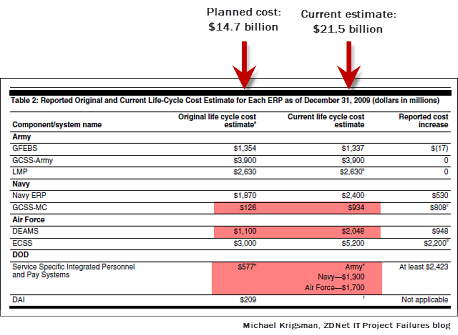Department of Defense IT: Years late and billions over-budget

A report by the Government Accountability Office (GAO) highlights $6.9 billion in over-budget IT projects at the Department of Defense (DoD). These projects were originally budgeted at $14.7 billion.
In addition to describing problems, the GAO analysis provides excellent advice that private-sector business leaders can apply immediately to improve their IT success rate.
Most of the late, over-budget Defense portfolio consists of ten large ERP projects. These projects are intended to "replace over 500 legacy systems that reportedly costs hundreds of millions of dollars to operate annually."
Aside from the obvious impact of cost overruns, the report points out that delays on projects of this type force the organization to waste additional money on obsolete systems:
[F]fund the operation and maintenance of the legacy systems longer than anticipated, thereby reducing funds that could be used for other DOD priorities.
The following table, from the report pdf, shows budgeted costs and costs for Department of Defense ERP projects. The report includes a description of each of these projects, so check there if you want more detail.
I have annotated the chart with total costs and highlighted the worst projects. Some of the cost over-runs are astounding, for example, one project was budgeted at $126 million and is now estimated at $934 million.
Click the chart to see a larger version:
STRATEGIC ANALYSIS
From an IT perspective, these projects are complicated, highly technical programs involving elaborate integrations and strict security requirements. However, to appreciate why they are delayed, we must remember these initiatives represent major capital expenditures no different from any other business investment.
Project delays and cost overruns of this type typically represent management, rather than technical, challenges. The report cites several causes, including: "inadequate requirements management, systems testing, ineffective oversight over business system investments".
Advice for enterprise buyers. A clear message emerges from this analysis: project success requires business management to be an essential partner with IT in bringing programs to completion. Both IT and the business must find ways to communicate and collaborate more effectively, in order to achieve mutual success.
To cultivate successful programs and projects, start by creating systematic methods and processes that bring IT and the business together. Beyond that, always consider large projects to be business investments no different from any other.
For many organizations, these simple ideals can be difficult to implement in practice, but importance of success warrants substantial investment of time, effort, and management attention.
